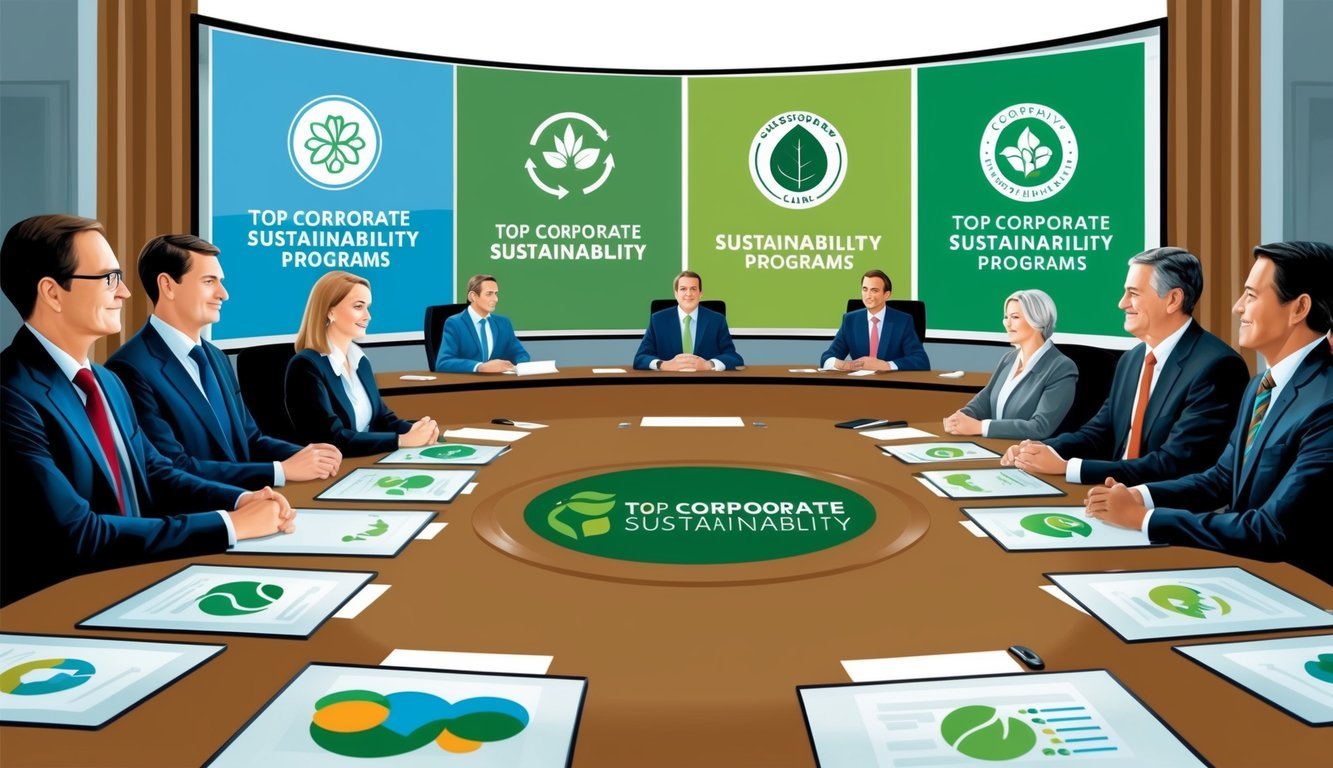Companies are stepping up their game when it comes to sustainability.
From tech giants to innovative startups, businesses are getting creative about reducing their environmental footprint.
And let’s be real—these efforts aren’t just good for the planet; they can also pump up a company’s profits and reputation.

**You might be surprised by the cool sustainability programs out there.** Whether it’s investing in green technology or launching eco-friendly product lines, companies are trying all sorts of new tricks.
Let’s check out six corporate sustainability programs making a splash in the business world.
## 1) Google’s Green Initiative

Google’s really making big strides to be eco-friendly.
Their ambitious goal to be powered by carbon-free energy every single day by 2030 is worth a shout-out.
This means tapping into clean energy sources like solar and wind.
You might be wondering how they’re planning to pull this off.
They’ve got batteries to store extra energy and AI to help predict when they’ll need a boost.
But Google isn’t stopping there.
They’re also aiming for net-zero emissions across their entire operation—offices, data centers, and even their supply chain.
They’re even lending a hand to other businesses, offering tools to help track carbon footprints.
If you’re interested, they provide *free training* on sustainability too, with courses that show how tech can be a force for good.
By stepping up like this, Google’s proving that big companies can lead the charge against climate change.
Who says you can’t do well by doing good?
## 2) Apple’s Carbon Neutral 2030 Plan

You’ve probably heard about Apple’s goal to become carbon neutral by 2030.
It’s a bold move aimed at cutting down pollution from their products and operations.
They’ve already nailed carbon neutrality in their offices since 2020 and are now pushing to clean up their entire supply chain.
Over 175 suppliers are converting to clean energy—bringing renewable power to the grid in a big way.
You might even notice changes in Apple products with a higher use of recycled materials and less polluting shipping methods.
Apple’s even investing in nature-based solutions, taking bold steps—albeit one step at a time.
## 3) Unilever’s Sustainable Living Plan

Unilever’s Sustainable Living Plan is a game-changer in corporate sustainability.
It kicked off back in 2010 with some lofty goals, aiming to bring real, positive change.
One of the key focus areas was sustainable sourcing of agricultural raw materials, and they’ve managed to increase their sustainable sourcing from just 14% to 67% by 2020.
But they’re not just sitting back; Unilever is now a key player in corporate sustainability’s next era, focusing firmly on making tangible impacts fast.
They’re tackling plastic waste, improving living standards within their supply chain, and shooting for net zero.
## 4) Patagonia’s Environmental Grants Program

Did you know Patagonia isn’t just about making top-notch outdoor gear? They’re passionate about protecting the planet too.
Their Corporate Grants Program provides funding to grassroots organizations focused on environmental conservation.
How cool is that?
Patagonia gives away 1% of its sales for environmental causes—over a nice chunk of change to support meaningful initiatives.
They’re all about backing projects that tackle the root of environmental issues, wanting to create lasting change rather than quick fixes.
And here’s a neat twist: Patagonia employees get a say in who receives the grants.
It’s not just boardroom decisions; it’s about making a community impact.
## 5) IKEA’s People & Planet Positive Strategy

IKEA is another company really stepping up its eco-friendly game.
Their People & Planet Positive Strategy aims to inspire over a billion people to live sustainably.
And you thought they just built flat-pack furniture!
The furniture giant wants to be climate positive, meaning they aim to reduce more greenhouse gas emissions than their entire value chain produces.
Pretty ambitious, huh?
IKEA’s also focused on using resources wisely, reducing waste, and reviewing their strategy every year to keep up with the latest science and regulations.
Their approach covers not just the environment but also fairness for people and better living for all.
## 6) Microsoft’s Carbon Negative by 2030

Microsoft isn’t just making software; they’re taking big steps to tackle climate change too.
The tech giant wants to be carbon negative by 2030, which means they plan to remove more carbon from the atmosphere than they emit.
Their plan includes cutting greenhouse gas emissions by over half and tackling the rest through innovative technologies.
There’s even a Climate Innovation Fund on the horizon to invest in green projects.
With this ambitious agenda, Microsoft shows how large corporations can lead the way in environmental responsibility, inspiring others to follow suit.
## Understanding Corporate Sustainability

Corporate sustainability is all about running a business responsibly, balancing profits with positive impacts on people and the planet.
When companies embrace sustainability, they often see benefits like cost savings, improved reputations, and long-term advantages.
### Why It Matters
Why should we care about sustainability? Because it helps protect our planet for future generations.
By adopting eco-friendly practices, we reduce waste and pollution, which can ultimately cut costs.
Plus, it turns out customers are pretty fond of companies that show they care.
Sustainable practices can also boost employee enthusiasm—many folks want to work for businesses making a difference.
And hey, investors are taking notice too; sustainability signals good management and forward-thinking.
### Core Principles
The main ideas behind corporate sustainability include:
1. **Environmental care:** Reduce your carbon footprint and use resources wisely.
2. **Social responsibility:** Treat your workers fairly and support your community.
3. **Economic viability:** Ensure your business can thrive in the long run.
Want to practice these principles? You could:
– Harness renewable energy in your offices.
– Offer fair wages and good working conditions.
– Create products that last longer or can be recycled.
If you’re keen to learn more, consider checking out some sustainability-focused MBA programs—they can guide you on balancing profits with people and planet concerns.
### Benefits of Corporate Sustainability Programs

Corporate sustainability programs bring some serious perks for both companies and the planet.
These initiatives don’t just help businesses survive; they allow them to thrive while making a positive impact.
#### Environmental Impact
Sustainability programs help cut down on waste and pollution.
You’ll use fewer resources and create less rubbish, which is a win for nature.
Many companies are switching to clean energy, reducing harmful emissions and possibly even using eco-friendly materials in their products.
Some might plant trees or support conservation efforts; little actions can lead to big changes in fighting climate change.
Your company can be a force for positive environmental change!
#### Economic Advantages
Going green can mean saving money.
Energy-efficient technology and practices often lead to lower bills—who doesn’t want that? Plus, eco-friendly brands tend to attract customers, boosting sales and even allowing companies to charge a bit more for sustainable products.
Green practices can ignite creativity too.
Companies might develop innovative products or find better ways of working.
It also helps attract top talent; many folks want to work for companies that prioritize the planet.
It’s a win-win.
### Challenges in Implementing Sustainability Programs

Starting a corporate sustainability program isn’t a walk in the park.
You might face common hurdles along the way.
One major challenge is getting leadership on board, especially since some executives might be focused on short-term profits instead of long-term sustainability goals.
Consider taking some corporate governance courses to help leaders see the financial and ethical benefits of sustainability.
Let’s look at some common obstacles and how to tackle them.
#### Common Obstacles
Money tends to be a big issue. **Sustainability efforts can be costly** upfront—even if they save cash down the line.
You might struggle to get approval for eco-friendly tech or practices.
A lack of know-how can trip you up too.
Your team might not have the skills to plan or execute green initiatives effectively, leading to mistakes.
And, keeping track of data can be another sticky point.
It’s tough to measure the impact of your sustainability efforts without reliable metrics, making it harder to prove your program’s worth.
#### Overcoming Resistance
Change can be daunting.
Some of your coworkers may be hesitant to adopt new, greener practices.
They might worry about added workload or having to learn new skills.
To win people over, show them the upsides.
Explain how sustainability boosts both the company’s image and bottom line, and share success stories from others who have gone green.
Make it easy for folks to get involved.
Offer training and resources, create simple steps for new processes, and celebrate each small win to keep morale high.
And hey, remember: patience is key.
Significant change takes time, but your sustainability efforts will pay off.
### Frequently Asked Questions

Many companies are taking bold steps to be more eco-friendly and socially responsible.
They’re setting ambitious goals, changing their business practices, and genuinely making a difference.
#### What are some examples of sustainability initiatives many companies have adopted?
A lot of businesses are now harnessing renewable energy like solar and wind power, cutting waste, and using recycled materials.
Some even have programs to plant trees or clean up our oceans!
#### Who’s leading the pack in corporate sustainability right now?
Google is a top contender with its clean energy push.
Apple aims for carbon neutrality by 2030.
Unilever and Patagonia are also big players in the sustainability game.
#### What are common environmental sustainability actions taken by businesses?
Companies often start by working on energy reduction and waste.
They might switch to LED lighting or go paperless.
Others focus on using less water or finding greener packaging options.
#### Can you list a few companies known for their strong CSR programs?
IKEA shines with its People & Planet Positive plan, while Patagonia gives grants for environmental initiatives.
Unilever’s Sustainable Living Plan is another noteworthy example.
#### What are some goals companies aim for to become more sustainable?
A lot of companies aim to reduce carbon emissions or fully transition to renewable energy.
Many want all packaging to be recyclable and set targets for diversity in hiring or community support.
#### How do businesses integrate ESG considerations into their strategies?
Companies often start by identifying their biggest impacts and setting goals around environmental issues, worker safety, or ethical sourcing.
Some create special teams to focus on sustainability efforts throughout the organization.
Sustainability is more than just a buzzword—it’s a vital part of how the best companies are moving forward.
After all, a better planet means better business, right?

